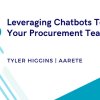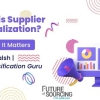A lot of the talk of RPA today is about bright new names challenging the established order: plucky newcomers forcing their way past the giants of outsourcing and technology. But what do the giants themselves have to say about this? Tata Consultancy Services (TCS) is one such business, and it turns out they are not sitting around waiting for their business models to be hollowed out. Live Wires met Vijay Damle, VP and Head of Business Process Services, to get the TCS perspective.
TCS is at the opposite end of the spectrum to our most recent profiles – emerging names Blue Prism and Genfour. TCS’ 350,000 staff are involved in IT development, software, consultancy, outsourcing and many other endeavours. Vijay notes without irony that their automation heritage goes all the way back to Pune, India, in the 1970s. RPA is certainly new, but for TCS it is also simply the latest leg in a 50-year automation odyssey.
For Vijay, automation is a fundamental, and compelling, force in business: “Organisations cannot keep throwing people at problems; people are a very expensive resource. It just doesn’t make sense to do the same work manually, over and over. Repetitive work means boredom and attrition. A lot of our workforce is in their mid to late twenties and will not stick around for this.” RPA is the latest tool to address this problem.
Vijay and his colleagues are already very busy making RPA happen for clients. So far TCS has configured, implemented, and run robotic software in banking, education, health, retail, manufacturing, life sciences, and professional services. This is consistent with the wave of RPA activity that I and other advisers and commentators are seeing across business. Vijay notes that as of today, “there is more demand than we can supply.” The talk about robotics is turning into action.
TCS has been rolling out RPA for a number of years, making it one of the earliest movers in this nascent technology. It targets 20-40% efficiencies for the processes it automates, in areas such as Accounts Payable or Operations. After initial pilots, live implementations follow, with eventual headcount savings anywhere between 50 to 1,000 roles over 9 to 12 months.
The potential benefits extend beyond efficiency. “RPA results in cost savings for sure. But it also frees up money for other things, such as innovation. So if I am a CIO or COO, I can now access so much new, granular data. I can see new patterns in transactions and operations. Every RPA transaction has an audit trail, so I get a new ability to get insights and data to regulators.”
To date TCS prefers to respond to demand amongst its outsourcing client base. This may change as its capabilities continue to develop. Some TCS RPA deployments have used third-party RPA software, such as Blue Prism, or Openspan, while others have used the home-grown TCS RPA platform based on Microsoft architecture. The TCS product uses four robotic ‘siblings’, each specialising in a different type of activity: one robot that moves content between systems, a second that consolidates information, a third that produces reports and analysis, and the last that organises the other robots. (For the record, TCS has also launched a new Artificial Intelligence (AI) tool for infrastructure automation, with about a dozen installations. More on AI in future posts).
So when it comes to RPA, what value would a company like TCS add? Vijay sets out a few reasons. Firstly, as noted, RPA is one part of a spectrum of automation and transformation activities. These can be joined up, consistent and reinforcing – or not. In theory working with a large, experienced partner promises more joined up thinking than a best-of-breed approach. If you are buying RPA, you might also need to buy OCR, re-engineer some of your processes, and change your organisation. A start-up RPA provider will not be able to cover the bases; a global systems integrator and outsourcer might.
Secondly, there will always be people somewhere in the process. Today’s buyers of RPA are very unlikely to be able to completely automate a given process. The reality is that your RPA solution will still entail handoffs, authorisations and large chunks of manual processing – so if not you, who will deliver this? “We haven’t come across a single process where end-to-end, ‘virtual outsourcing’ is possible. You still need the people element.”
Thirdly, getting RPA right is not as easy as you might imagine. “Most clients underestimate the prep needed before you switch RPA on. People are sold RPA as if you are installing MS Office on your home laptop. Very often clients have progressed with RPA without support – and we’ve been brought in to clean up the mess.” Specifically RPA implementation requires excellent design, but also very strong change planning and management. Vijay asks “How do you teach people to manage a mixed team of people and machines?” A good question, and the answer is not obvious.
In summary it seems the role of an organisation like TCS is in fitting RPA into a broad agenda for transformation. Do you see RPA a point solution, or is it part of something bigger? If as a company you have a great handle on the improvement opportunities in your IT, Finance, HR, Operations, Contact or other departments, and you understand how to go after them, then fine. But RPA will not help you to get there. In situations where you are looking for help, you might need to work with a global outsourcer, or – god forbid – the consultants.
Looking forward, Vijay notes that RPA may not always be a key part of the automation agenda. Today it is the latest tool, but over time it may be replaced by smarter, more integrated technology. “RPA is sophisticated, it is quick, but at the end of the day, it is a band-aid.” In two or three years’ time AI or other tools may push it aside.
But by that stage, the impact of RPA could already have been profound. Looking at TCS itself, Vijay sees it as part of a switch to becoming a ‘non-linear’ business. “In the past, we have grown only by adding people. RPA and other automation helps us to change this. We will continue to grow in terms of the value we deliver, but we will not need to add as many people as before. It will free up people to get closer to our clients.”
TCS could be at a turning point in its RPA journey. It recently sold its own RPA software product to an insurer that was not an outsourcing client – in other words it is a de facto entrant into the RPA software market, totally separate to its legacy outsourcing business. It seems that the full impact of RPA on the outsourcing landscape is only just starting to emerge.
Paul Morrison is a Partner at Aecus, the specialist outsourcing, shared service and automation consultancy. Follow him on Twitter at @MorrisonPaul1 and at aecus.com.








